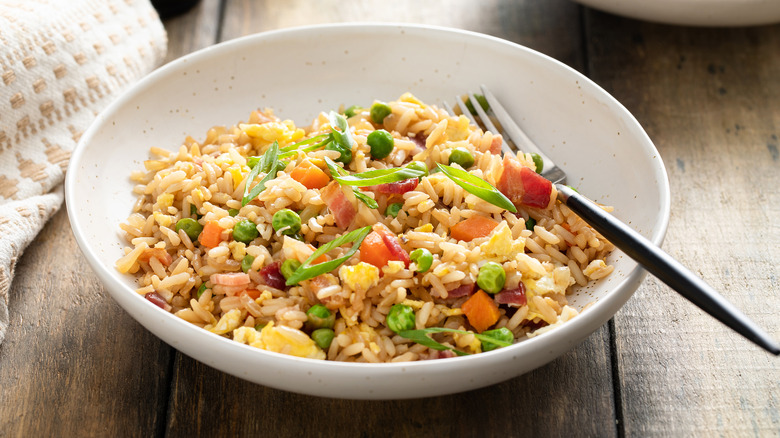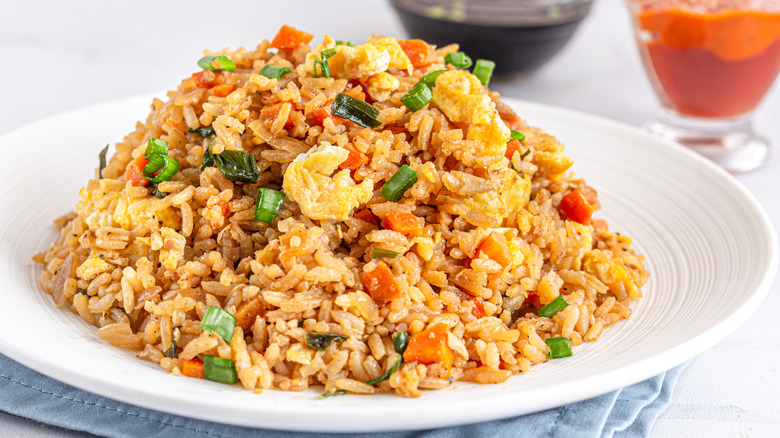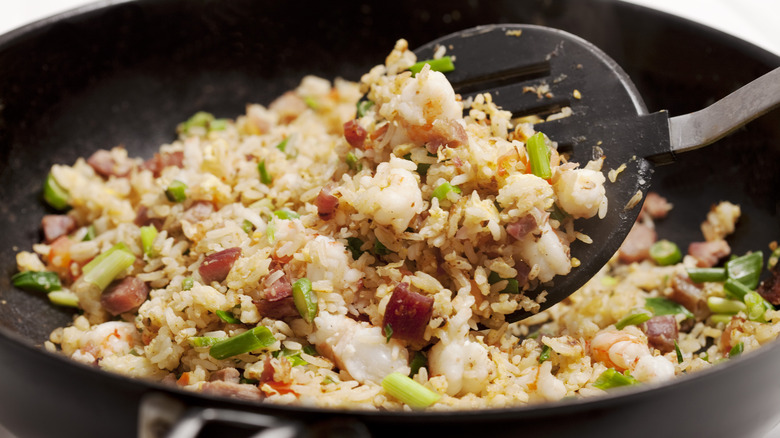The Ingredient Tips To Keep In Mind For The Best Homemade Fried Rice Ever
If you're a fan of Chinese takeout, you probably won't be surprised to hear that one of the most popular menu items is fried rice. It's a filling and hearty meal, bulked up with veggies, and sometimes meat or seafood, with a rich, salty flavor. However, sometimes you have the ingredients on hand to whip up a tasty fried rice recipe at home without too much hassle.
Jon Kung, food influencer and author of "Kung Food: Chinese American Recipes from a Third Culture Kitchen", spoke with Daily Meal and provided some exclusive insights into how to make great fried rice at home. For starters, he explains that you want rice that doesn't have too much moisture: "Dry that rice out," he says. This is why so many people swear by using day-old rice as a way to get a restaurant-quality fried rice dish. Doing so prevents clumping and sogginess, giving you that satisfying, crispy texture when you re-cook it. If you don't have day-old on hand, Kung recommends drying out freshly cooked rice on a baking sheet.
Kung also notes the way you put your fried rice together is important: "As a safety precaution for home cooking I always recommend cooking your meats first and then setting them aside before adding them in after the rice." He says how you cook your veggies depends on what kind you're using.
Different vegetables cook at different speeds
Jon Kung cautions home cooks to stir-fry certain vegetables in batches on their own with plenty of space in the wok, then adding the cooked rice afterward. If you stir in all your vegetables at once, you can wind up with some being raw, because of over-crowding and because different vegetables cook at different speeds.
Sweet potato, has a firm, starchy texture which means it often takes longer to cook through. If you add it too late in the game, you could wind up with an unpleasant crunch rather than a soft and sweet bite. On the other hand, veggies like celery and onion cook at a faster rate — this is why Kung advises cooking vegetables in batches that cook at similar speeds and setting them aside to mix in later. The size of the vegetables you're stir-frying matters, too. Kung notes, "if you're doing diced peas and carrots you could add them before or after the egg based on your preference."
It's safer to pre-cook your proteins
Jon Kung explains that one common wok mistake people make is to try to cook the raw meats right before adding the rice. He notes: "Putting things in raw and then building off of that tends to crowd a smaller home-sized wok, and you want to make sure everything is fully cooked before serving." Pre-cooking the proteins and setting them aside can help prevent serving undercooked meats, which can ultimately lead to foodborne illness. Although chicken and pork are two common culprits, uncooked seafood, such as shrimp, can also cause these issues. Meat and seafood always need to be cooked to the proper internal temperature.
Beyond helping you avoid food safety mistakes, cooking your meat ahead of time can also make serving the fried rice easier. If you're making a large amount of fried rice for a bigger group, you can portion out the rice, meat and vegetables more evenly when plating up. Just top with freshly sliced green onions and some sesame seeds, and you've got restaurant-worthy homemade fried rice.


